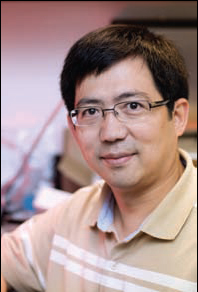A team of PMH scientists have created an organic nanoparticle that is completely non-toxic, biodegradable and nimble in the way it uses light and heat to treat cancer and deliver drugs. (A nanoparticle is a minute molecule with novel properties).
 The findings, published online in Nature Materials, are significant because unlike other nanoparticles, the new nanoparticle has a unique and versatile structure that could potentially change the way tumors are treated, says principal investigator Dr. Gang Zheng, Senior Scientist, Ontario Cancer Institute (OCI), PMH.
The findings, published online in Nature Materials, are significant because unlike other nanoparticles, the new nanoparticle has a unique and versatile structure that could potentially change the way tumors are treated, says principal investigator Dr. Gang Zheng, Senior Scientist, Ontario Cancer Institute (OCI), PMH.
"In the lab, we combined two naturally occurring molecules (chlorophyll and lipid) to create a unique nanoparticle that shows promise for numerous diverse light-based (biophotonic) applications, explains Dr. Zheng. "The structure of the nanoparticle, which is like a miniature and colorful water balloon, means it can also be filled with drugs to treat the tumor it is targeting."
It works this way, explains first author Jonathan Lovell, a doctoral student at OCI: "Photothermal therapy uses light and heat to destroy tumors. With the nanoparticle's ability to absorb so much light and accumulate in tumors, a laser can rapidly heat the tumor to a temperature of 60 degrees and destroy it. The nanoparticle can also be used for photoacoustic imaging, which combines light and sound to produce a very high-resolution image that can be used to find and target tumors." He adds that once the nanoparticle hits its tumor target, it becomes fluorescent to signal "mission accomplished".
"There are many nanoparticles out there, but this one is the complete package, a kind of one-stop shopping for various types of cancer imaging and treatment options that can now be mixed and matched in ways previously unimaginable. The unprecedented safety of this nanoparticle in the body is the icing on the cake. We are excited by the possibilities for its use in the clinic," says Dr. Zheng.
The research was financially supported by grants and fellowships from the Ontario Institute for Cancer Research, the Canadian Cancer Society, the Natural Sciences and Engineering Research Council of Canada, the Canadian Institutes of Health Research, the Joey and Toby Tanenbaum/Brazilian Ball Chair in Prostate Cancer Research, and in part from the Campbell Family Institute for Cancer Research and the Ministry of Health and Long-Term Care, and The Princess Margaret Hospital Foundation.
